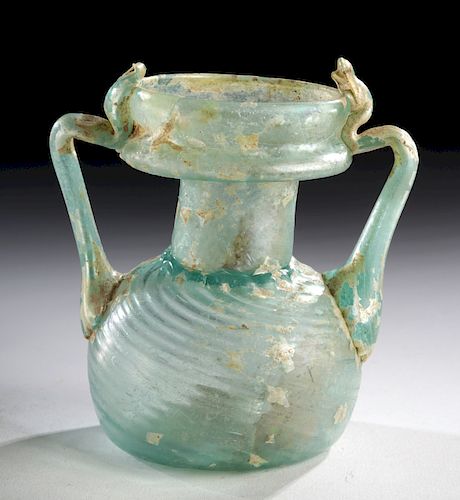Roman Holy Land Glass Sprinkler Vessel
Lot 56
About Seller
Artemis Fine Arts
686 S Taylor Ave, Ste 106
Louisville, CO 80027
United States
Selling antiquities, ancient and ethnographic art online since 1993, Artemis Gallery specializes in Classical Antiquities (Egyptian, Greek, Roman, Near Eastern), Asian, Pre-Columbian, African / Tribal / Oceanographic art. Our extensive inventory includes pottery, stone, metal, wood, glass and textil...Read more
Estimate:
$1,000 - $1,500
Absentee vs Live bid
Two ways to bid:
- Leave a max absentee bid and the platform will bid on your behalf up to your maximum bid during the live auction.
- Bid live during the auction and your bids will be submitted real-time to the auctioneer.
Bid Increments
| Price | Bid Increment |
|---|---|
| $0 | $25 |
| $300 | $50 |
| $1,000 | $100 |
| $2,000 | $250 |
| $5,000 | $500 |
| $10,000 | $1,000 |
| $20,000 | $2,500 |
| $50,000 | $5,000 |
| $100,000 | $10,000 |
| $200,000 | $20,000 |
About Auction
By Artemis Fine Arts
Jun 20, 2019
Set Reminder
2019-06-20 10:00:00
2019-06-20 10:00:00
America/New_York
Bidsquare
Bidsquare : Ancient / Ethnographic From Around the World
https://www.bidsquare.com/auctions/artemis-gallery/ancient-ethnographic-from-around-the-world-4217
Around the world & back in time - be amazed at the treasures you will find. Antiquities from Egypt, Greece, Italy and the Near East, Asian, Pre-Columbian, African / Tribal / Oceanic, Native American, Spanish Colonial, Russian Icons, Fine Art, much more! All categories, all price ranges.. all legal Artemis Fine Arts info@artemisfinearts.com
Around the world & back in time - be amazed at the treasures you will find. Antiquities from Egypt, Greece, Italy and the Near East, Asian, Pre-Columbian, African / Tribal / Oceanic, Native American, Spanish Colonial, Russian Icons, Fine Art, much more! All categories, all price ranges.. all legal Artemis Fine Arts info@artemisfinearts.com
- Lot Description
Roman Holy Land, Imperial Period, ca. 1st century CE. A stunning pattern molded glass sprinkler vessel comprised of pale blue-green glass with nice areas of translucence, its form presenting a bulbous body decorated with a swirled pattern, a tubular neck, a tooled funnel mouth with a constricted opening inside for sprinkling, and twin trailed handles joining rim to shoulder. The surface presents gorgeous silvery and rainbow iridescence. Size: 3.25" W handlespan x 3.5" H (8.3 cm x 8.9 cm)
Most scholars agree, Roman glass was of the highest quality - both aesthetically and technically - among the ancients. While glass making had been practiced for centuries, glass blowing was invented in the Roman-controlled Holy Land in the 1st century BCE. This innovative technology revolutionized the artform. We can appreciate such a wide variety of forms and shapes, because the medium of glass has unique physical properties that make for so many more possibilities which would eventually replace a wide variety of pottery and metal wares in the ancient world. Roman glassmakers reached incredible artistic heights with both free-blown vessels and mold blown forms and decorations and were traded far beyond the Roman Empire. Roman glass vessels have been found in Scandinavia, India, and in Han Dynasty tombs in China.
Provenance: private New York, New York, USA collection; ex-Elinor Katz collection, purchased in the 1970s from Barakat Antiquities, Jerusalem
All items legal to buy/sell under U.S. Statute covering cultural patrimony Code 2600, CHAPTER 14, and are guaranteed to be as described or your money back.
A Certificate of Authenticity will accompany all winning bids.
We ship worldwide and handle all shipping in-house for your convenience.
#146329Fissure to the rim with minute loss to upper end of trail handle. Otherwise intact. No pontil mark as this piece was mold-blown. Nice pattern molded decoration. Surface deposits as shown. Gorgeous rainbow and silvery iridescence.Condition
- Shipping Info
-
All shipping is handled in-house for your convenience. Your invoice from Artemis Gallery will include shipping calculation instructions. If in doubt, please inquire BEFORE bidding for estimated shipping costs for individual items.
-
- Buyer's Premium



 EUR
EUR CAD
CAD AUD
AUD GBP
GBP MXN
MXN HKD
HKD CNY
CNY MYR
MYR SEK
SEK SGD
SGD CHF
CHF THB
THB
















